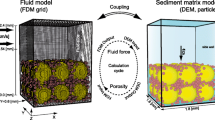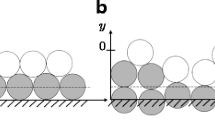Abstract
Blanketed sediment beds can have different bed mobility characteristics relative to those of beds composed of uniform grain-size distribution. Most of the processes that affect bed mobility act in the direct vicinity of the bed or even within the bed itself. To simulate the general conditions of analogue experiments, a high-resolution three-dimensional numerical ‘flume tank’ model was developed using a coupled finite difference method flow model and a discrete element method particle model. The method was applied to investigate the physical processes within blanketed sediment beds under the influence of varying flow velocities. Four suites of simulations, in which a matrix of uniform large grains (600 μm) was blanketed by variably thick layers of small particles (80 μm; blanket layer thickness approx. 80, 350, 500 and 700 μm), were carried out. All beds were subjected to five predefined flow velocities (U 1–5=10–30 cm/s). The fluid profiles, relative particle distances and porosity changes within the bed were determined for each configuration. The data show that, as the thickness of the blanket layer increases, increasingly more small particles accumulate in the indentations between the larger particles closest to the surface. This results in decreased porosity and reduced flow into the bed. In addition, with increasing blanket layer thickness, an increasingly larger number of smaller particles are forced into the pore spaces between the larger particles, causing further reduction in porosity. This ultimately causes the interstitial flow, which would normally allow entrainment of particles in the deeper parts of the bed, to decrease to such an extent that the bed is stabilized.










Similar content being viewed by others
References
Allen JRL (1970) Physical processes of sedimentation. Unwin University Books, London
Barkla HM, Auchterlonie LJ (1971) Magnus or robins effect on rotating spheres. J Fluid Mech 47:437–447. doi:10.1017/S0022112071001150
Bartzke G, Huhn K (2015) A conceptual model of pore-space blockage in mixed sediments using a new numerical approach, with implications for sediment bed stabilization. Geo-Mar Lett 35:189–202
Bartzke G, Bryan KR, Pilditch CA, Huhn K (2013) On the stabilizing influence of silt on sand beds. J Sediment Res 83:691–703. doi:10.2110/jsr.2013.57
Bear J, Verruijt A (2012) Modeling groundwater flow and pollution. Springer, Heidelberg
Billerbeck M, Werner U, Polerecky L, Walpersdorf E, deBeer D, Huettel M (2006) Surficial and deep pore water circulation governs spatial and temporal scales of nutrient recycling in intertidal sand flat sediment. Mar Ecol Progr Ser 326:61–76. doi:10.3354/MEPS326061
Black K, Paterson DM (1997) Measurement of the erosion potential of cohesive marine sediment: a review of current in situ technology. J Mar Environ Eng 4:43–83
Cundall PA, Strack ODL (1979) A discrete numerical model for granular assemblies. Géotechniqe 29:47–65
Cunningham E (1910) On the velocity of steady fall of spherical particles through a fluid medium. Proc R Soc Lond A 83:357–365. doi:10.1098/rspa.1910.0024
Drake TG, Calantoni J (2001) Discrete particle model for sheet flow sediment transport in the nearshore. J Geophys Res Oceans 106:19859–19868. doi:10.1029/2000JC000611
Durán O, Andreotti B, Claudin P (2012) Numerical simulation of turbulent sediment transport, from bed load to saltation. Phys Fluids 24:103306. doi:10.1063/1.4757662
Eisbacher GH (1996) Einführung in die Tektonik. Spektrum, Stuttgart
Grass AJ (1971) Structural features of turbulent flow over smooth and rough boundaries. J Fluid Mech 50:233–255. doi:10.1017/S0022112071002556
Harris JW, Stöcker H (1998) Handbook of mathematics and computational science. Springer, Heidelberg
Heald J, McEwan I, Tait S (2004) Sediment transport over a flat bed in a unidirectional flow: simulations and validation. Philos Trans Ser A Math Phys Eng Sci 362:1973–1986. doi:10.1098/rsta.2004.1426
Healy T (2002) Muddy coasts of mid-latitude oceanic islands on an active plate margin–New Zealand. In: Healy T, Healy J-A (eds) Muddy coasts of the world – processes, deposits and function, Proceedings in marine science, vol 4. Elsevier, Amsterdam, pp 347–374
Huettel M, Webster IT (2001) Porewater flow in permeable sediments. In: Bernard P, Boudreau B, Jorgensen B (eds) The benthic boundary layer: transport processes and biogeochemistry. Oxford University Press, New York, pp 144–179
Itasca (2004a) FLAC 3D 3.1 Manual. Itasca Consulting Group, Inc., Minneapolis
Itasca (2004b) PFC 3D 3.1 Manual. Itasca Consulting Group, Inc., Minneapolis
Jacobs W, Le Hir P, Van Kesteren W, Cann P (2011) Erosion threshold of sand-mud mixtures. Cont Shelf Res 31:14–25. doi:10.1016/j.csr.2010.05.012
Jiang Z, Haff PK (1993) Multiparticle simulation methods applied to the micromechanics of bed-load transport. Water Resour Res 29:399–412. doi:10.1029/92WR02063
Julien PY (1998) Erosion and sedimentation. Cambridge University Press, Cambridge
Kock I, Huhn K (2007) Influence of particle shape on the frictional strength of sediments - a numerical case study. Sediment Geol 196:217–233. doi:10.1016/j.sedgeo.2006.07.011
Komar PD (1987) Selective grain entrainment by a current from a bed of mixed sizes - a reanalysis. J Sediment Petrol 57:203–211. doi:10.1306/212F8AE4-2B24-11D7-8648000102C1865D
Le Hir P, Cann P, Waeles B, Jestin H, Bassoullet P (2008) Erodibility of natural sediments: experiments on sand/mud mixtures from laboratory and field erosion tests. In: Kusuda T, Yamanishi H, Spearman J, Gailani JZ (eds) Sediment and ecohydraulics, Proceedings in marine science, vol 9. Elsevier, Amsterdam, pp 137–153
Leeder MR (1999) Sedimentology and sedimentary basins: from turbulence to tectonics. Blackwell Science, Oxford
Mao L, Cooper JR, Frostick LE (2011) Grain size and topographical differences between static and mobile Armour layers. Earth Surf Proc Landf 36:1321–1334. doi:10.1002/esp.2156
McCave IN (1984) Erosion, transport and deposition of fine-grained marine sediments. Geol Soc Lond Spec Publ 15:35–69
Middleton V (2003) Encyclopedia of sediments and sedimentary rocks. Kluwer Academic, Dordrecht
Miller MC, McCave IN, Komar PD (1977) Threshold of sediment motion under unidirectional currents. Sedimentology 24:507–527. doi:10.1111/j.1365-3091.1977.tb00136.x
Mitchener H, Torfs H (1996) Erosion of mud/sand mixtures. Coast Eng 29:1–25. doi:10.1016/S0378-3839(96)00002-6
Mouilleron H, Charru F, Eiff O (2009) Inside the moving layer of a sheared granular bed. J Fluid Mech 628:229–239. doi:10.1017/S0022112009006636
Panagiotopoulos I, Voulgaris G, Collins MB (1997) The influence of clay on the threshold of movement of fine sandy beds. Coast Eng 32:19–43. doi:10.1016/S0378-3839(97)00013-6
Paphitis D (2001) Sediment movement under unidirectional flows: an assessment of empirical threshold curves. Coast Eng 43:227–245. doi:10.1016/S0378-3839(01)00015-1
Parker G, Klingeman PC (1982) On why gravel bed streams are paved. Water Resour Res 18:1409–1423. doi:10.1029/WR018i005p01409
Partheniades E (1965) Erosion and deposition of cohesive soils. ASCE, J Hydraul Div Proc 91(HYl):105–138
Patil VA, Liburdy JA (2013) Flow characterization using PIV measurements in a low aspect ratio randomly packed porous bed. Exp Fluids 54:1–19. doi:10.1007/s00348-013-1497-3
Peskin CS (1972) Flow patterns around heart valves: a numerical method. J Comput Phys 10:252–271. doi:10.1016/0021-9991(72)90065-4
Precht E, Franke U, Polerecky L, Huettel M (2004) Oxygen dynamics in permeable sediments with wave-driven pore water exchange. Limnol Oceanogr 49:693–705. doi:10.2307/3597786
Schlichting H, Gersten K, Gersten K (2000) Boundary-layer theory. Springer, Heidelberg
Schmeeckle MW (2014) Numerical simulation of turbulence and sediment transport of medium sand. J Geophys Res Earth Surf 119:1240–1262. doi:10.1002/2013JF002911
Shields A (1936) Anwendung der Ähnlichkeitsmechanik und der Turbulenzforschung auf die Geschiebebewegung. Mitteilungen der Preußischen Versuchsanstalt für Wasserbau und Schiffbau 26:26
Shuwei Z, Cioppa MT, Shihong Z (2010) Spatial variations in particle size and magnetite concentration on Cedar Beach: implications for grain-sorting processes, western Lake Erie, Canada. Acta Geol Sinica (English Edition) 84:1520–1532. doi:10.1111/j.1755-6724.2010.00345.x
Soulsby R (1997) Dynamics of marine sands. A manual for practical applications, Thomas Telford, London
Soulsby R, Whitehouse R (1997) Threshold of sediment motion in coastal environments. In: Centre for Advanced Engineering, Pacific Coasts and Ports ‘97, Proc 13th Australasian Coastal and Ocean Engineering Conf and 6th Australasian Port and Harbour Conf, 7–11 September 1997, Christchurch. University of Canterbury, Christchurch, vol 1, pp 145–150
Strikwerda JC (1989) Finite difference schemes and partial differential equations. Wadsworth, Pacific Grove
Sutherland A (1987) Static Armour layers by selective erosion. In: Thorne CR, Bathurst JCR, Hey D (eds) Sediment transport in gravel-bed rivers. Wiley, London, pp 243–280
Torfs H (1997) Erosion of mixed cohesive/non cohesive sediments in uniform flow. In: Burt N, Parker R, Watts J (eds) Cohesive sediments. Wiley, Chichester, pp 245–252
Torfs H, Jiang J, Mehta AJ (2001) Assessment of the erodibility of fine/coarse sediment mixtures. Coast Estuar Sediment Proc 3:109–123
Tucker ME (1981) Sedimentary petrology. Blackwell, Oxford
van Ledden M, van Kesteren WGM, Winterwerp JC (2004) A conceptual framework for the erosion behaviour of sand–mud mixtures. Cont Shelf Res 24:1–11. doi:10.1016/j.csr.2003.09.002
van Rijn LC (1984) Sediment transport, part I: bed load transport. J Hydraul Eng 110:1431–1456. doi:10.1061/(asce)0733-9429(1984)110:10(1431)
Venditti JG, Dietrich WE, Nelson PA, Wydzga MA, Fadde J, Sklar L (2010) Effect of sediment pulse grain size on sediment transport rates and bed mobility in gravel bed rivers. J Geophys Res Earth Surf 115:F03039. doi:10.1029/2009JF001418
Whitehouse R, Soulsby R, Roberts W, Mitchener H (2000) Dynamics of estuarine muds. A manual for practical applications, Thomas Telford, London
Wiberg PL, Smith JD (1987) Calculations of the critical shear stress for motion of uniform and heterogeneous sediments. Water Resour Res 23:1471–1480
Wilcock PR (2001) Toward a practical method for estimating sediment-transport rates in gravel-bed rivers. Earth Surf Proc Landf 26:1395–1408
Williamson HJ (1991) Tidal transport of mud/sand mixtures - a literature review. Sediment Distributions Report SR 286, Wallingford
Winterwerp JC, Van Kesteren WGM (2004) Introduction to the physics of cohesive sediment in the marine environment. Elsevier, Amsterdam
Acknowledgements
This work has been funded through the Deutsche Forschungsgemeinschaft DFG-International Research Training Group INTERCOAST and DFG grant BA 5243/1-1. We gratefully acknowledge the constructive comments of an anonymous reviewer and the journal editors, as well as feedback and help from L. Podszun and J. Kuhlmann.
Author information
Authors and Affiliations
Corresponding author
Ethics declarations
Conflict of interest
The authors declare that there is no conflict of interest with third parties.
Electronic supplementary material
ESM 1
(PDF 319 kb)
Rights and permissions
About this article
Cite this article
Bartzke, G., Huhn, K. & Bryan, K.R. A computational investigation of the interstitial flow induced by a variably thick blanket of very fine sand covering a coarse sand bed. Geo-Mar Lett 37, 457–474 (2017). https://doi.org/10.1007/s00367-017-0502-x
Received:
Accepted:
Published:
Issue Date:
DOI: https://doi.org/10.1007/s00367-017-0502-x




